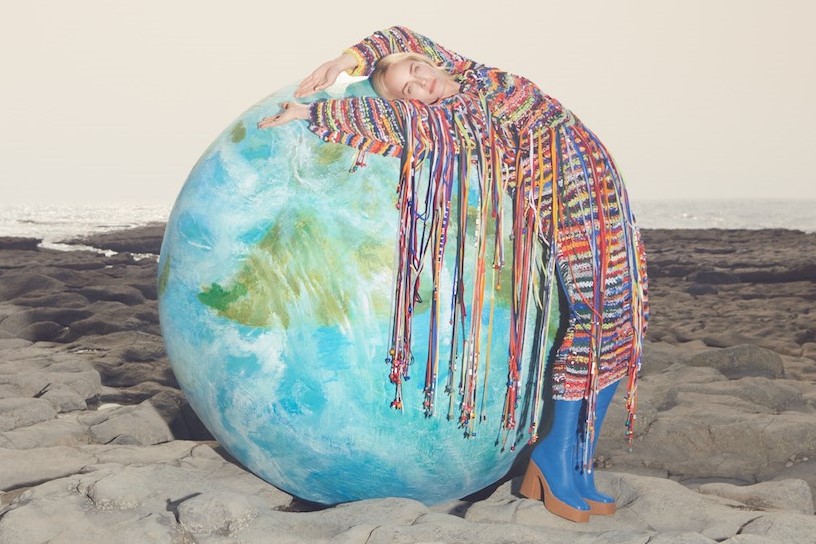
What would a sustainable fashion future actually look like?
With fashion glaringly absent from the conversation at COP26, Dazed’s sustainability columnist imagines what real change could mean for the industry
A pandemic, wildfires, floods, droughts, the prospect of unlivable conditions within the next 50 years, and a climate change report which signalled “code red for humanity” mean Glasgow’s COP26 is a crucial moment in humanity’s future. But fashion, which if it were a nation state would rank at the 7th largest economy in the world, has been glaringly absent from the conversation.
To redress the balance, signatories from the fashion industry including Fashion Revolution, Centre for Sustainable Fashion, New Standard Institute, and Labour Behind the Label have united in a call to action, asking the world’s leaders to commit to five key recommendations.




The prompts? “Collective action to achieve net zero emissions by no later than 2050; resourcefulness in waste elimination; increase responsibility by businesses towards their global supply chains; support skills development in education to encourage children to learn the necessary skills to make, repair and reuse their clothes; and frame any solutions to the climate emergency around business models which shift the focus from profit and loss, to a just transition towards the well-being economy”.
We’ve had a significant taste of what lies ahead if governments fail to act, but what might the fashion industry of the future look like if the call to action inspired leaders to actually lead?
DECARBONISING THE INDUSTRY
By 2016, the apparel and footwear industries accounted for approximately 8 per cent of global greenhouse gas (GHG emissions). In 2019, the UK government passed a law to bring all GHG emissions to net zero by 2050. But the same month, it rejected every recommendation made in the Environmental Audit Committee’s Fixing Fashion report which included making environmental targets for retailers with a turnover of £36m and above in line with WRAP’s Textiles 2030 initiative.
As the government prepared to host COP26, all carbon targets and initiatives, including the UN’s Fashion Industry Charter for Climate Change remain voluntary and brands continue to make impressive-sounding sustainability declarations that don’t begin to make a dent in the climate crisis. However when the Green Claims Code comes into force in 2022, brands find it increasingly difficult to make unfounded, sweeping environmental claims. With the Climate Clock striking seven years until the window for action to limit warming to 1.5 degrees closes, and consumer scrutiny at an all-time high, brands begin to sign up to standards and initiatives to win back trust, including the Science Based Targets Initiative net-zero corporate standard. All targets must be aligned with the goal of this 1.5 degrees – there’s no more tolerance for anything less.
“As the government prepared to host COP26, all carbon targets and initiatives, including the UN’s Fashion Industry Charter for Climate Change remain voluntary and brands continue to make impressive-sounding sustainability declarations that don’t begin to make a dent in the climate crisis”
The joint effect of the Green Claims Code and the need to make science-based targets mean offsetting, often in the form of planting trees, no longer cuts it. But voluntary action allows fast fashion overproducers to drag their heels so governments, finally, step in. A coalition of the biggest fashion consuming nations lay down a plan: coal-fired heat and power generation must be phased out within three years, and virgin polyester must go within ten. Tax reforms reward companies who design products with lower environmental impacts and penalise those who don’t, and incentives are offered for brands investing in regenerative farming to restore biodiversity and reduce land pressure.
By 2040, the UK has an appointed Fashion Minister. A switch to renewables is mandated and carbon reports across the entire supply chain must be made public. The message is clear: brands no longer make their own rules.
WASTE NOT
In 2017, less than 1 per cent of material used to produce clothing was recycled into new clothing. Meanwhile brands were destroying unsold stock and sending billions of pounds worth of returns to landfill, while consumers continued to throw clothes in the bin.
Designers attempted to fix the problem. 2019 saw the launch of fully circular shoe brand Thousand Fell who joined the likes of Nudie Jeans, Helen Kirkum, and Duran Lantink in embracing the circular economy, but the linear ‘take-make-waste’ system continued to drive fashion. By 2020, the industry was producing over 100 billion garments per year, and countries in the Global South, like Ghana, were flooded with cast-offs from the Global North, the quality so low that 40 per cent of it went straight to landfill. The same year, France introduced an anti-waste law which prevented the destruction of unsold items, and in 2021 the Repairability Index was introduced, meaning manufacturers had to rate their electrical products out of ten on how easy they were to repair.
A shift towards Extended Producer Responsibility and an EU directive for members to set up separate textile collections by 2025 floods the secondhand textile market as existing infrastructure isn’t prepared for the volume of clothes consumers throw away to make room for new. A series of import bans echo the plastic import bans from the likes of Turkey and China earlier in the decade, and manufacturers find themselves lumbered with the waste they created.
“By 2020, the fashion industry was producing over 100 billion garments per year, and countries in the Global South, like Ghana, were flooded with cast-offs from the Global North, the quality so low that 40 per cent of it went straight to landfill”
Revisiting recommendations made to the previous administration, a new government takes action: a sliding scale levy on each garment made, ranging from 2p per garment to 8p for higher volumes, used to fund recycling innovation and circular design education. It quickly adds up for the brands producing millions of garments and the effect takes hold: selling lots of clothes at low prices makes way for selling less at a higher price tag.
After extended campaigning from the Right to Repair movement, 2035 sees the introduction of fashion guarantees, with brands obliged to offer free repairs for up to three years after purchase. Unravelling seams, broken zips, missing buttons, and frays can all be repaired on-demand. Keen to avoid the levy for producing new garments and monetise their new consumer repairs infrastructure, brands began to utilise the service model, as developed by Professor Rebecca Earley. Designed for disassembly, garments are bought on contract, much like phones. When they’re worn out or out of style, consumers can return them to be overprinted, restructured, and, eventually when reworks are no longer possible, turned into smaller pieces such as bags and accessories.
Jaan Muhammad, a journalist with KTN, was among those textile workers who were beaten up by Sindh Police and men in civvies today when they wete protesting for their fundamental rights like minimum wage and social security.#releaseyaseenjhullanpic.twitter.com/fmqXqB3HXv
— Fawad ?? (@FawadHazan) October 11, 2021
TAKING RESPONSIBILITY
A lethal factory collapse in 2013, and a complete absolution of liability to pay garment worker wages during COVID-19 illustrated how the fashion industry had shirked responsibility for those within its supply chain.
Signed in May 2013 and renewed in 2018, The Accord on Fire and Building Safety in Bangladesh helped to identify 87,000 safety issues and eliminate over 90 per cent of them. At risk of disappearing when it came up for renewal in 2021, after extended campaigning a new International Accord was created, with the rules stating it must expand into at least one country outside Bangladesh within 26 months. The same year, the EU announced mandatory legislation on due diligence to ensure “respect for human rights and the environment throughout the entire supply chain”.
“A lethal factory collapse in 2013, and a complete absolution of liability to pay garment worker wages during COVID-19illustrated how the fashion industry had shirked responsibility for those within its supply chain. Signed in May 2013 and renewed in 2018, The Accord on Fire and Building Safety in Bangladesh helped to identify 87,000 safety issues and eliminate over 90 per cent of them”
By 2023, the due diligence legislation is being adopted by member states. Brands must identify suppliers, even those outside of Europe, and take responsibility for any harm caused to workers – or the environment – and make sure that any victims have access to legal remedies like compensation. In 2025, California’s Garment Worker Protection Act, which ensures hourly wages rather than payment by the garment, is expanded to New York.
After a fed-up buyer shares a recording of a colleague talking down a supplier from £3.70 to £3.19 per unit just before Christmas 2029, #StoptheSqueeze protesters gather outside the headquarters of fast fashion giants on New Year’s Day, demanding they stop driving down prices and squeezing garment worker wages. Campaigners call on the government to ring fence labour costs in production orders to ensure workers receive a living wage, and a new administration adopts the policy: garment worker pay must be accounted for in order prices. Ruthless haggling is out.
By 2037, the Accord is implemented in Vietnam, Pakistan, India, Cambodia, and Sri Lanka. Once brands could cut ties with problematic supplier factories, tweet an apology and move on, but now they are on the hook, legally, for safety inspections, training, and corrective action in all their major manufacturing hubs.
@bagelluvr247 an attempt to diy harry’s jw anderson sweater so i can slowly steal his personality #diy #harrystyles #upcycle #crochet #Kolors
♬ breezeblocks x take a slice – Cole Russo
RESKILLING THE MASSES
In 2017 the make do and mend mindset had been lost to time. 6 per cent of people couldn’t sew confidently or at all, and half asked their mothers to fix their clothes for them. However, the COVID-19 pandemic saw history repeat itself as a crisis gave rise to crafting. While ‘shellshocked’ WWII veterans undertook embroidery therapy, and those on the home front knitted for victory, a more isolated existence during the pandemic saw visits to craft guide platforms skyrocket as people knitted, crocheted, sewed, and crafted their way through COVID.
A decade of homogenous polyester from fast fashion brands saw a rise in the popularity of visible mending and creative reworking as people sought out individuality and evidence of the human touch. COVID-19 had another key impact: high street store closures. By 2025, high streets are largely vacant and local economies are suffering. Birdsong’s Sophie Slater and TRAID’s Maria Chenoweth have continued to push for rent control and subsidised high street spaces for social enterprises and community groups. Finally heeding their call and, as part of its promise to move towards a circular economy, the UK government offers prominent retail space to the Repair Café network, and over the next decade the number of cafés doubles in size.
“In 2017 the make do and mend mindset had been lost to time. 6 per cent of people couldn’t sew confidently or at all, and half asked their mothers to fix their clothes for them. However, the COVID-19 pandemic saw history repeat itself as a crisis gave rise to crafting”
The gap between the demand for repairs versus the people who have the skills to provide them is stark. A 38 per cent decrease in arts GCSEs between 2010 and 2019, coupled with the government’s 2024 decision to go ahead with limiting numbers on certain arts degrees has created a major need for reskilling.
In 2031 after an extended campaign by educators, fashion academics, and right to repair activists, who used the success of the Climate Leaders Award as a catalyst, repair is on the curriculum. As graduates of the new repair education come of age throughout the following decade, emerging as the next key consumer demographic, their proclivity to repair rather than replace loosens fast fashion’s grip on the youth market. This generation doesn’t want transience, it demands permanence via creativity.
WELLBEING OVER WEALTH
As the chasm between the poor and the wealthy grew, GDP began to feel like an outdated framework with which to measure progress. “(GDP) measures income, but not equality, it measures growth, but not destruction, and it ignores values like social cohesion and the environment. Yet governments, businesses and probably most people swear by it,” said the OECD. Seeking an alternative, Bhutan created Gross National Happiness measuring points such as psychological wellbeing and community vitality, Wales launched the Well-being of Future Generations Act 2015, and New Zealand introduced a Wellbeing Budget in 2019, but they remained outliers in a GDP-focused world.
2019 saw Extinction Rebellion protest at London Fashion Week, their signs reading “There’s no fashion on a dead planet”, and garment worker protests ramped up post-COVID. Initially, with governments focused on rebuilding their economies at any cost, regulation appears to be off the table. However, as the Great Resignation builds momentum and the workforce depletes over the following years, progressive governments explore alternative models, and wellbeing budgets appear to provide the answer.
Following suit, an updated Fashion Pact is launched in 2024, pairing the existing environmental pillars with those of the wellbeing economy. Signatories must take a regenerative approach where their manufacturing operations have displaced local trade, investing in conserving and rebuilding artisanal and indigenous crafts and textiles markets. Public reporting on payment of the living wage across the entire supply chain is targeted and brands must aim to have a net positive impact on all communities they operate within across five areas: pollution, air quality, education, health, and equality.
With the US and the UK lagging behind on regulation, in the latter half of the 20s and the early 2030s New York and London Fashion Week become hotspots for protest. Maintaining the status quo becomes untenable and both the BFC and the CDFA co-opt the Fashion Pact’s wellbeing economy framework. No living wage, and no progress means no show.



